
| KIT #: | 82164 |
| PRICE: | $49.95 |
| DECALS: | Five options |
| REVIEWER: | Tom Cleaver |
| NOTES: | Profipack |

| HISTORY |
By the Spring of 1944, the Bf-109G-6, which had been the primary production version of Messerschmitt’s fighter since the previous fall, was falling behind in the relentless race for performance. Beginning in the late spring, many airframes were re-engined with the DB605D, on which an increased-diameter supercharger had been fitted and compression raised to from 7.3/7.5 to 8.3/8.5, using standard B4 (87 octane) fuel with methanol-water (MW50) injection, to provide 1,800 h.p. for take-off and 1,600 h.p. at 6,000 meters. That summer, production “standardized” on the Bf-109G-14, which could use this engine or the DB605CD, which utilized C3 (96 octane) fuel and MW50 to provide 2,000 h.p. for take-off and 1,800 h.p. at 6,000 meters.
That fall, the redesigned Bf-109K-4 came into production and reached the Jagdwaffe beginning in mid-November 1944.
 The Bf-109G-10 began life as a way of modernizing the Bf-109G-6 airframe
to make it as much like a Bf-109K as possible. This version, all of which were
re-manufactured G-6 airframes, did not enter service until January 1945, after
the introduction of the Bf-109K-4, which has spread no small amount of confusion
among Bf-109 “experten”. Coupled with the fact that the G-10 could appear with
either engine, with or without an extended-leg tail wheel like the K-4, with or
without the taller wooden rudder of the K-4, G-14, and late production G-6, and
with or without the larger wheels and associated upper wing fairing of the K-4
variant, it is close to impossible unless one can discern a Werkenummer in a
photograph, and has access to a list of sub-types by serial number (and even
then it is not a 100% lock since the records are not totally complete), to
determine if one is looking at a Bf-109G-6AS, a Bf-109G-14AS, or a Bf-109G-10.
There are few photos available of any of these late war types to top it off. The
only version of the Bf-109G-10 that can absolutely be identified as such is the
Erla-built version, due to the fact that it lacked the curved cowling fairing on
the left side of the forward fuselage immediately below the windscreen, this
being replaced by a square-shaped panel. Additionally, this sub-type does not
have under cowl bulges on the lower nose, and does have a shallower, wider oil
cooler radiator.
The Bf-109G-10 began life as a way of modernizing the Bf-109G-6 airframe
to make it as much like a Bf-109K as possible. This version, all of which were
re-manufactured G-6 airframes, did not enter service until January 1945, after
the introduction of the Bf-109K-4, which has spread no small amount of confusion
among Bf-109 “experten”. Coupled with the fact that the G-10 could appear with
either engine, with or without an extended-leg tail wheel like the K-4, with or
without the taller wooden rudder of the K-4, G-14, and late production G-6, and
with or without the larger wheels and associated upper wing fairing of the K-4
variant, it is close to impossible unless one can discern a Werkenummer in a
photograph, and has access to a list of sub-types by serial number (and even
then it is not a 100% lock since the records are not totally complete), to
determine if one is looking at a Bf-109G-6AS, a Bf-109G-14AS, or a Bf-109G-10.
There are few photos available of any of these late war types to top it off. The
only version of the Bf-109G-10 that can absolutely be identified as such is the
Erla-built version, due to the fact that it lacked the curved cowling fairing on
the left side of the forward fuselage immediately below the windscreen, this
being replaced by a square-shaped panel. Additionally, this sub-type does not
have under cowl bulges on the lower nose, and does have a shallower, wider oil
cooler radiator.
What is known definitely about the Bf-109G-10 is that it was the final type to equip Squadrigli of the Aviazione della R.S.I., as well as the last type to equip the Croatian Jagdstaffel that flew with the Italians, and that it was issued interchangeably with the Bf-109K-4 to Luftwaffe Geschwadern in the last months of the war. It was acknowledged as the fastest of the series, with a top speed at altitude of 452 m.p.h., slightly faster than the Bf-109K-4. As far as having any effect on the war, the airplane may as well not have existed; by the time it arrived, the Luftwaffe had shot its final bolt in Operation Bodenplatte, and was a spent force with few leaders left alive, fewer pilots of any ability left on operations, and an uncertain supply of aviation gasoline which meant most of these airplanes were supplied to a unit that never flew them before they were lost to Allied strafing in the few months after the Battle of the Bulge that spelled the end of the Nazis and their “Thousand-Year Reich.”
Erich Hartmann:
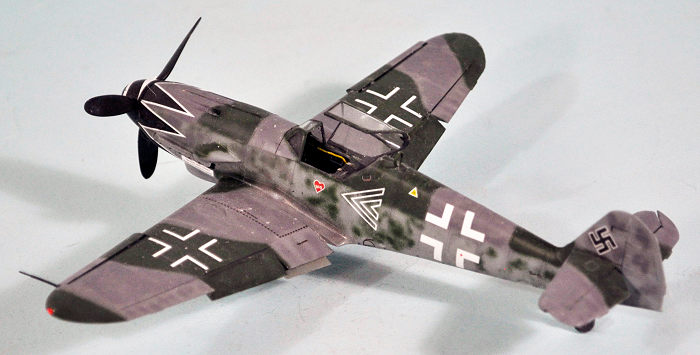 Erich Hartmann’s name is well-known to aviation enthusiasts as the
highest-scoring ace of all history with 352 aerial kills.
Erich Hartmann’s name is well-known to aviation enthusiasts as the
highest-scoring ace of all history with 352 aerial kills.
This score is even more amazing when one considers that he did not arrive at the front until the summer of 1942 - well past the "glory days" of the Luftwaffe. Once he got over his "buck fever" - he turned tail and ran when he entered his first combat - Hartmann was a gifted pilot in a target-rich environment. He was always outnumbered by his Soviet foes. Flying three and four missions a day every day, he had over 100 victories by the conclusion of the Battle of Kursk in July 1943 - a year after he entered combat - and another 100 by the end of 1943. Beginning with the mission of July 7, 1943, Hartmann began scoring multiple victories because he had learned the essential trick of a successful fighter pilot, to close to point-blank range before opening fire. This way, it only took three or four hits with his 20mm cannon to explode an enemy fighter. As he put it, "Get close. When he fills the entire windscreen, then you can’t possibly miss." . Hartmann claimed that - of all his accomplishments - he was proudest of the fact that he never lost a wingman.
Born in 1922, in Weissach, Wurttemberg, Hartmann joined the Luftwaffe in 1941 at age 19, and was posted to Jagdgeschwader 52 on the Eastern Front in October, 1942. He scored his first kill that November, and only achieved his second three months later.
As he worked out the tactics which would prove so successful later on during the Spring of 1943, he would normally be content with one victory, being willing to wait for another day. His natural talents began to tell: excellent eyesight, lightning reflexes, an aggressive spirit, and an ability to stay cool while in combat. As he developed the coolness to close with the enemy, he started scoring multiple victories, such as his missions on February 26, 1944, when he scored his 200th victory. That day, he shot down ten P-39 Airacobras over three sorties.
In June and July 1944, operating in Romania, Hartmann engaged in combat with American fighters for the first time, and shot down six, including American ace Ralph “Kidd” Hofer, one of the “personalities” of the Fourth Fighter Group when that unit operated in Italy after taking part in the first shuttle mission to the USSR in late June.
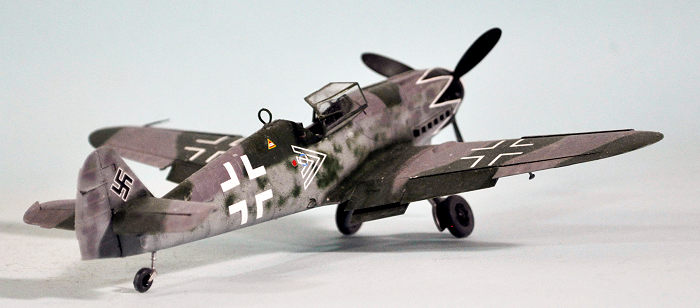 Over the month of August 1944, Hartmann claimed 35 victories, including
eight on August 23, which was followed the next day by shooting down 11 enemy
aircraft to become the first pilot to score more than 300 victories.
Over the month of August 1944, Hartmann claimed 35 victories, including
eight on August 23, which was followed the next day by shooting down 11 enemy
aircraft to become the first pilot to score more than 300 victories.
Following this, Hartmann was prohibited from flying combat and assigned to Erprobungskommando 262. In October, the prohibition on combat flying was lifted and he was appointed Staffelkapitän of 4./JG 52, then in Hungary. By the end of the year, his tally was 331. Hartmann briefly led I/JG 53 as acting Gruppenkommandeur from February 1-14, 1945, before turning over command to Hauptmann Helmut Lipfert and becoming Gruppenkommandeur of I/JG 52. In March he was transferred to Lechfeld for training on the Me 262 to join JV 44, but he requested a return to JG 52, due to his feeling that the young pilots needed his skills more than the experten of JV 44 did. On April 17, he scored his 350th victory, and was promoted to Major at the end of the month. On May 8 - the last day of the war - he claimed his 352nd, and last, victory against a Yak-9 over the Brün area in Czechoslovakia.
Later that day, the Luftwaffe command ordered Hartmann and his Kommodore, Hermann Graf, to fly to the British sector. Both disregarded the order because they were responsible for Jagdgeschwader 52's pilots, ground crew, family members, and other civilians who had joined the squadron seeking protection against Czech partisans. They ordered the destruction of the unit’s aircraft, then moved west. At the end of the day, they surrendered to the U.S. Army on the Bavarian-Czech border. However, on May 17th, the Americans delivered members of JG 52 to the Soviets.
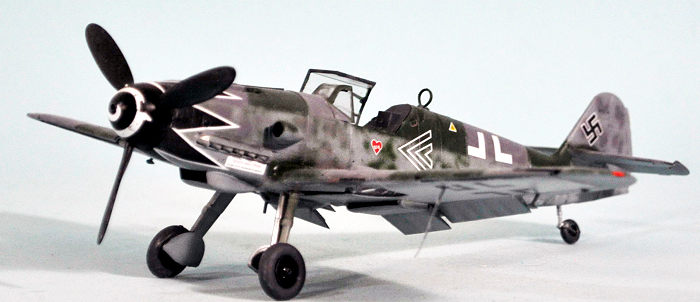 With the rest of the unit, Hartmann was sent to Siberia, where he was
sentenced to 50 years at hard labor. During his imprisonment, the Soviets
pressured him to support the establishment of an East German air force and tried
to turn him into an undercover agent against the West. He refused, even though
the Soviets threatened to kidnap and kill his wife and daughter, who were living
in West Germany. Hermann Graf accepted the offer and was released from the gulag
in 1953. Hartmann returned to Germany on October 15, 1955, when the last German
POWs were released following the establishment of diplomatic relations between
West Germany and the Soviet Union.
With the rest of the unit, Hartmann was sent to Siberia, where he was
sentenced to 50 years at hard labor. During his imprisonment, the Soviets
pressured him to support the establishment of an East German air force and tried
to turn him into an undercover agent against the West. He refused, even though
the Soviets threatened to kidnap and kill his wife and daughter, who were living
in West Germany. Hermann Graf accepted the offer and was released from the gulag
in 1953. Hartmann returned to Germany on October 15, 1955, when the last German
POWs were released following the establishment of diplomatic relations between
West Germany and the Soviet Union.
In 1956, he joined the newly-established Bundesluftwaffe and in 1959 became the first Kommodore of Jagdgeschwader 71 "Richthofen." His career suffered when he opposed the introduction of the F-104 Starfighter into the Bundesluftwaffe on grounds that the service did not have the experience to successfully operate such a high performance jet at that time, an opinion later proven right with the horrendous loss rate and fatalities following the F-104's entry into operations up until the mid-1970s.
Retiring as a Colonel in 1970 over these severe differences with his old comrade Gunter Rall - the leader of the F-104 faction in the Bundesluftwaffe - Erich Hartmann died in 1993. He had flown 825 missions in recording 352 victories, a record for endurance in combat. His victories included 15 Il-2 Sturmoviks. He was shot down and force-landed 14 times during his combat career.
| THE KIT |
This Bf-109G-10 Erla is the first kit of this sub-type produced in 1/48. Previously a modeler who wanted to do this sub-type needed to find a resin conversion. Eduard provides an entirely different fuselage, canopy, and cockpit interior to cater to the specifics of the Erla-built G-10. Decals are provided for five different aircraft, including the final Bf-109 flown by Erich Hartmann.
| CONSTRUCTION |
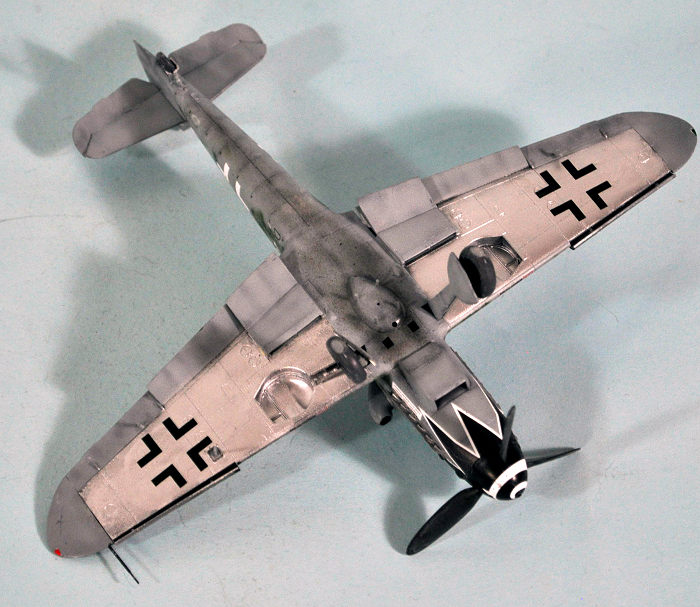 The Bf-109G series kits are easily the least-fiddly 1/48 kits Eduard has
yet released. Modelers who want a super-detailed cockpit may opt for one of the
many resin cockpits out there, but for most, what is in the kit will be fine -
particularly since it’s all dark grey RLM66 anyway. The Profipack photoetch
provides all the instrument panels and the seatbelts.
The Bf-109G series kits are easily the least-fiddly 1/48 kits Eduard has
yet released. Modelers who want a super-detailed cockpit may opt for one of the
many resin cockpits out there, but for most, what is in the kit will be fine -
particularly since it’s all dark grey RLM66 anyway. The Profipack photoetch
provides all the instrument panels and the seatbelts.
The fit of the kit overall is very precise and you must take the time to completely clear off any sprue nubs, and keep paint off the mating surfaces since that would be enough to throw things off.
After assembling and painting the cockpit, I assembled the fuselage and then assembled the wing, and joined the two sub-assemblies, then added on the horizontal stabilizers. All the control surfaces are separate; the kit is designed to have the flaps lowered and the radiator flaps open. Using care in assembly, you will not need to use any filler anywhere on the kit.
| COLORS & MARKINGS |
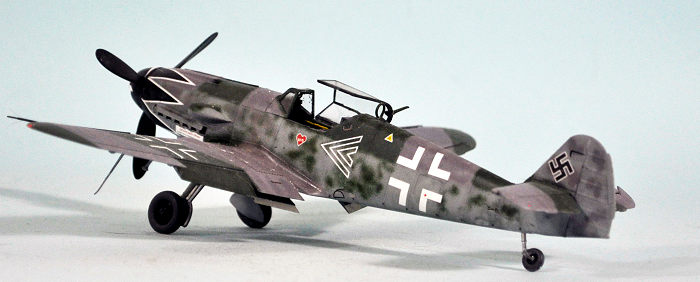 I painted the wing lower surface with Tamiya X-18 Semi-gloss Black for a
primer, then covered that with Vallejo Aluminum. After it dried I used low-tack
drafting tape to mask off, then proceeded to pre-shade and then paint the rest
of the model in a Luftwaffe late war scheme of 75/82/76, using the excellent
painting and decaling illustration.
I painted the wing lower surface with Tamiya X-18 Semi-gloss Black for a
primer, then covered that with Vallejo Aluminum. After it dried I used low-tack
drafting tape to mask off, then proceeded to pre-shade and then paint the rest
of the model in a Luftwaffe late war scheme of 75/82/76, using the excellent
painting and decaling illustration.
I chose to do Hartmann’s last airplane. The excellent Cartograf decals went on without problem.
Figuring that this 109 didn’t see a lot of use, I didn’t ding it, and only gave it some exhaust staining. I then unmasked the canopy and positioned it open, and attached the landing gear and prop.
| CONCLUSIONS |
If Eduard didn’t “own” the 109 series before, they do now. I particularly like that they don’t do “modular” kits like Hasegawa would, but rather do full molds of different fuselages. They have announced a K-4, G-12, s-199 and CS-199 to come. They only lack the Jumo-powered early versions, which it wouldn’t surprise me to see them do in the future.
As with any of their kits, if a modeler commits the revolutionary act of following the instructions, the result is pretty much guaranteed: an excellent model. Highly recommended.
4 June 2020
Review kit courtesy of Eduard.
If you would like your product reviewed fairly and fairly quickly, please contact the editor or see other details in the Note to Contributors.
Back to the Main Page Back to the Review Index Page Back to the Previews Index Page